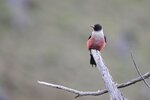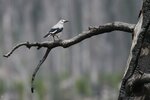

Recently I was asked how the hobby of bird watching began. Of course, people in every time, country and culture have paid attention to birds, if only to understand how to exploit them for food by hunting or domestication. And one of the mysteries that puzzled ancient Greek thinkers was where the birds went in winter.
A small part of the European age of exploration, very subordinate to the pursuit of wealth and the conquering of “new” lands, was the documentation of the new life forms found in these lands. Initially, most of the investigation centered on usefulness: can we eat it?
By the early 1800’s, some exploration activities had expanded to include gathering specimens of the various life forms encountered and sending them back to universities and other institutions. The Lewis and Clark Expedition of 1803-05 is a classic example. Among many other things, they collected bird skins of new species to be studied and named. Thus, in Washington we have both the Lewis Woodpecker and the Clark’s Nutcracker on our state bird list.
The study of birds – ornithology – was then conducted indoors where researchers examined skins and nests. Imagine studying and classifying birds without listening to their songs! The major field tool in those days was a low-gauge shotgun with a weak charge of powder. This was the primary investigation technique employed by John J. Audubon to acquire specimens for his famous paintings.
These early ornithologists had one good excuse for not studying birds in the field – binoculars had not yet been invented. There were telescopes, but for nature study, telescopes had several problems, including that the image viewed was upside down. This made, and makes, no difference in some uses – there is no upside or downside in space (despite the illusion we all hold that the North Pole is “up” and the South Pole “down.”). It also makes no difference with a microscope.
Researchers in optics addressed this difficulty in several ways that, ultimately, solved the upside-down problem by inserting one or more additional lenses in the tube between the light-catching end and the eyepiece. These new vision-enhancing items were each handmade and expensive. Thus, one of the first uses of these inventions was opera glasses, allowing wealthy opera patrons to view the opera, and each other, in detail. And, of course, in the intervening 150 years, binoculars have evolved into a standard field tool readily available for all.
There is a heroine to this story, and she is Florence Merriam Bailey. She was born in upstate New York to a family of naturalists, including her well-known older brother C. Hart Merriam. She spent her younger years out-of-doors and was encouraged to do so. She became a keen nature observer.
While she was attending Smith College, a women’s college, she organized a bird-watching club, encouraging her sister students to pay attention to birds. The 1880’s women’s hats were dominated by styles that demanded bird feathers – the more, the better. Florence, not surprisingly, was revolted by this style and campaigned against it, but in a rather subtle way – by getting the other students to get interested in birds as an object of curiosity rather than a fashion statement.
She also, in 1886, organized a chapter of the then-new Audubon Society at the college and submitted articles about her bird observations to Audubon Magazine. When she left in 1886 a substantial portion of the students were members. (That Audubon Society chapter and membership tradition still persists at Smith College). Her guidance to others was simple; she asked students to observe "how the birds look, what they have to say, how they spend their time, what sort of houses they build, and what are their family secrets." That is a great summary of bird watching!
In 1890 the Audubon Society and its magazine went out of business for a time. Florence decided to take her bird profiles and collect them into a book, Birds Through an Opera-Glass. In addition to the account of specific birds, she also included information for readers to assist them in how to think about, observe and classify birds.
Florence Merriam Bailey married and afterward traveled to the Western U.S. She continued her studies of birds and had many more publications. But it is that first book that had the greatest influence. It not only encouraged amateurs but also professionals to go outdoors and study what the birds were actually doing, and saying, and not just what they looked like in a museum.
This single book, which is still in print and available online, was the inspiration of bird watching as it is today. Thank you, Florence - we all owe you a debt.
George Walter is environmental program manager at the Nisqually Indian Tribe’s natural resources department; he also has a 40+ year interest in bird watching. He may be reached at george@theJOLTnews.com
Photos for this column are provided by Liam Hutcheson, a 16-year-old Olympia area birder and avid photographer.
1 comment on this item Please log in to comment by clicking here
Terrilovesanimals
Thank you! We love birds too and love learning from posts like yours!
Friday, July 21, 2023 Report this